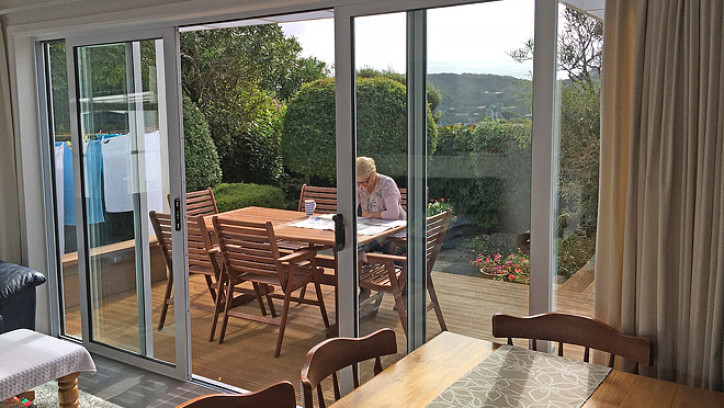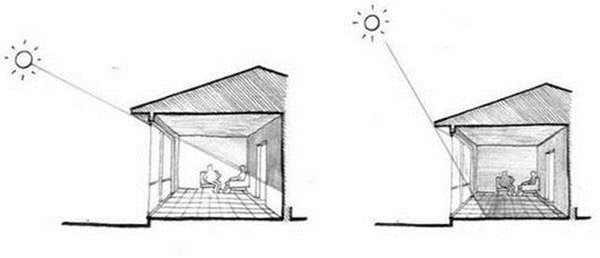Passive cooling
Last updated: 9 August 2023

Passive cooling can help keep your home comfortable throughout summer without using an air conditioner or other mechanical assistance.
Keeping your cool
Overheating is a common summer problem in many New Zealand homes, and is likely to get worse with climate change. Passive cooling can help you keep your home comfortable throughout summer without using an air conditioner or other mechanical assistance.
Passive cooling works by:
- using shade and insulation to keep heat out of your home in summer
- using heat-storing materials such as concrete to absorb heat
- using breeze and air movement inside your home to keep you cool.
Passive cooling is free, unlike air conditioning which is expensive to install and run.
Passive cooling should be part of an overall approach to passive design. Depending on your situation (climate, house style, personal preferences, etc) it is most effective if you incorporate the principles of both passive cooling and passive heating.
Passive heating has more information.
When should you think about passive cooling?
Planning a home or renovation
If you are building or renovating, passive cooling should be considered early in the design process.
Good design should strike a balance between the need to keep your home warm in winter, the need to keep it cool in summer and the need to provide ventilation to bring fresh, healthy air into your home. So passive cooling should be considered alongside passive heating and ventilation options.
In your existing home
Many passive cooling options can be easily added to existing homes. Simple but effective options include using plants or awnings to shade windows from the outside.
Another way to improve passive cooling in an existing home is by installing extra insulation – contrary to popular myth, a well-insulated home keeps cool in summer because the insulation stops the heat from the sun on the roof and walls from seeping into the house, just like a chilly bin. However, sunlight will still get through windows, regardless of whether they are double glazed. Therefore windows are one of the most important elements to protect, either through shading or by choosing glass with special treatments.
Glazing treatments
Glazing treatments can reduce the amount of heat getting into your home from the sun. They come in different colours and shading levels. While low-emissivity coatings are usually used to reduce heat loss through a window, they can also be installed in a way to reduce solar gains entering through the window.
Tinting is another treatment. Your designer and glazing supplier will be able to give you an overview of the options available.
Keep in mind that although such glazing treatments will keep some of the sun's heat out, they are less effective than external shading.
Also remember that during winter you may want to capture as much solar heat as possible. A solar-treated window will reduce sunlight not only in summer but also in winter.
However, glazing treatments can be a good option if it is impractical to install external shading. In particular west-facing windows can sometimes be difficult to shade because of the low sun angle in the afternoon. In those cases window tinting can be the best solution.
Shading
Shading should be designed to take into account the sun's path on your site in summer and winter. The sun travels higher in the sky in summer, so north-facing windows shading can be designed to keep summer sun out but let winter sun in. If you already live in your home the easiest way to check the sun’s path is by observation. If it is a new home you can get a smartphone app that uses the phone's camera to provide a map the sun takes across the sky. From this, you can get a very good idea where it will be at different times during the day throughout the year.
NIWA SolarView is a useful tool that shows you the sun's path at your site.
BRANZ Level website also provides useful information.
While your exact needs will vary according to your site and climate, most people will want to:
- shade high-angle summer sun from the north
- shade low-angle summer sun from the east and west
- let low-angle winter sun into your home from all directions.
In general, you'll need eaves or some other form of shading above glazing on the north side of the house – but the size and type will depend on your circumstances.
Fixed shading
Fixed shading options include:
- eaves
- pergolas
- fixed louvres
- covered balconies (note: a balcony on the north side of your home could block winter sun)
- plants.
Eave design
Eaves should be designed to let as much sun as possible into your home in winter (when the sun is low in the sky) but keep the sun out in summer (when it's higher in the sky). The exact design of the eaves will depend on the amount and position of glazing in your home, which way it faces and the amount of direct sunlight you want to come into your home.
If the situation is quite involved you (or your designer) can model the travel of the sun through the building in both summer and winter. If you want specific details on year-round comfort of individual rooms, you’ll need to get a specialist using a computer program.

Eaves can be designed to provide shade during summer and let sunlight in during winter.
Planting for shade
Planting provides flexible shade options:
- Deciduous vines and trees let winter sun through, and provide summer shade.
- Ground-cover plants keep surface and ground temperatures lower in summer, as well as reducing glare – use plants instead of hard paving in outdoor living areas exposed to direct summer sun.
- A shaded courtyard next to the main living area can act as a cool air well.

Deciduous trees provide shade in summer but let filtered light in through winter.
Adjustable shading
Adjustable shading provides flexibility. It can be especially useful where you need to deal with low-angle morning or evening sun.
External shading options that stop the sun getting to your windows at all will keep your home cooler. Internally, light coloured or metallic Venetian blinds or light coloured curtains can also help, especially with a window open to let the heat back out. Note that external shading is much more effective than internal shading. Adjustable shading options include:
- manually adjustable louvres
- shutters
- light coloured curtains
- venetian blinds – these are more effective than Roman or Holland blinds because they allow airflow to let hot air out
- sliding screens
- retractable awnings and sails
- removable shades that can be taken down at the end of summer.
Adjustable shading may be combined with fixed eaves or pergolas to provide deep shade in summer, but allow winter sun into these areas.
Insulation
A well-insulated home will retain heat in winter and keep heat out in summer. Ceiling insulation is particularly important to keep the hot sun from overheating your home – and painting your roof a light colour will reflect sunlight, meaning that less heat penetrates through the roof.
Remember your windows when you think about insulation. Solar-treated glass will help keep the heat out in summer, but will also reduce solar gain in the winter.
Insulating your home and Glazing and glass options have more information.
Ventilation
Air movement keeps you cool by increasing the rate at which moisture evaporates from your skin. You'll need more air movement as humidity increases.
You can harness air movement by:
- orienting your home to catch the prevailing breeze
- using passive ventilation to get air circulating through your home
- combining passive ventilation with ceiling fans to direct the incoming cooler air where you need it.
Passive ventilation uses doors, windows and, opening skylights to let fresh air into and through your home. This helps to provide cooling, as well as removing moisture and airborne pollutants.
For ventilation effectiveness it is best to have a house design that lets air flow easily from one side of the house to the other. If your house is built into a slope with different floor levels you can open windows in the lower and the upper floor levels to utilise the stack effect of warm air rising up.
Leave your windows open to let breezes through your house. It’s a good idea to use security stays to prevent burglary (even if you’re home) and children falling or climbing out.
Windy site challenges
Slowing down, or excluding strong hot summer winds can be a challenge.
In some cases, the prevailing hot summer wind, sun and views are all orientated north.
It is important to know the regional climate and the site's microclimate when you are planning a new home or renovation, so that wind direction can be considered.
On windy sites, consider:
- putting doorways and some windows into sheltered recesses so they can be opened even when it's windy to let warm air out
- using windows and doors on the south and east side of your home to provide for air movement without gusts if the prevailing wind is from the north
- using sliding windows – they won't slam shut in the wind
- using small openings – one at ground level and one in the roof or on an upper level – to provide for ventilation on windy days
- using wind breaks and mounded plantings around your home to slow the wind down and change the wind path.
Air conditioning and heat pumps
Air conditioning or cooling with heat pumps can use significant amounts of electricity and require the home to be closed off from the outside environment to work best.
It dries the internal air and can harbour and spread bacteria if not maintained.
If passive design principles are followed and some supplementary cooling is still required, other options such as fans are more cost-effective than air-conditioning. Even if your heat pump is very energy efficient, you will find your power bills going up if you use it for summer cooling.
Cooling and air conditioning has more information.
Homestar
Use the Homestar online tool to see how well your home performs and get recommendations on how to improve it, or book a certified assessment.